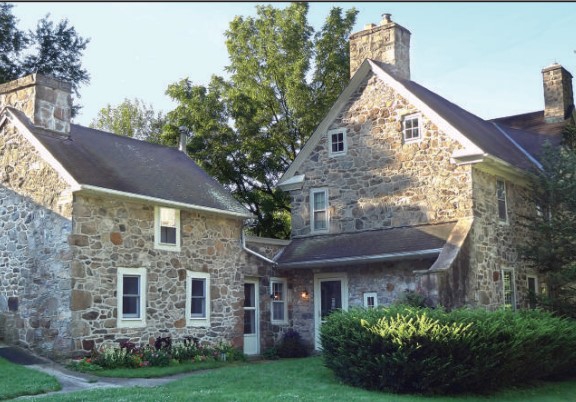Radnor Historic Properties Remain in Jeopardy

The Holly Tree House has stood on what is now Ardrossan Farm since before the Revolutionary War. Gen. George Washington’s troops came there for food in the winter of 1777-1778.
But the future of the stone house, thought to be the oldest house in Radnor, is now in doubt because the parcel it stands on is for sale, and Radnor Township does not have an ordinance in place to protect historic properties townshipwide.
Phil Graham, who lives nearby, is concerned that once the parcel is sold, there is nothing to prevent the new owner from razing the Holly Tree House the next day.
Graham, a former Radnor Historical Society board member, said residents concerned about historic preservation have been trying for years to get an overlay ordinance to protect the hundreds of historic properties in the township.
Currently, three historic districts exist in Wayne: North Wayne, South Wayne, and Louella. But buildings in other sections do not enjoy any protection.
“So this is urgent. Holly Tree House is far from the only site. Hundreds of buildings and sites must be nominated if Radnor’s unique history is to stand any vague chance of protection from being here today and gone tomorrow. And I truly mean tomorrow,” Graham said.
Historian Greg Prichard, secretary of the RHS but speaking for himself, said the township’s comprehensive plans since at least 1988 have recommended adopting a historic overlay district to protect old houses and buildings. When the plan was updated in 2003, it again called for an ordinance. But subsequent boards of commissioners (BOC) did not adopt it.
The Ardrossan Estate is historical and the last large property to be developed in the township. Ardrossan inspired “The Philadelphia Story,” a play and movie based loosely on the late socialite Hope Montgomery Scott, who Katharine Hepburn portrayed.
“I really hope the township will consider it,” Prichard said about an ordinance to protect historic buildings. Prichard is the historic preservation planner for neighboring Lower Merion Township, which does have ordinances protecting landmark properties. Radnor has “a lot of great historic places.”
An ordinance would mean a property owner would have to have the Board of Commissioners’ approval before demolishing a historic building. “It gives the township an extra layer of protection,” Prichard said.
Cathy Cavalier-Gach helped shepherd an ordinance for Newtown Square. It was adopted in September after a 20-year process.
But before it could be adopted, “We lost many properties,” she said. “Many on the Dupont property (now a housing development). The development properties are most at risk.”
“We only had five properties (covered by the ordinance) initially. Now there are 100,” said Cavalier-Gach, president of the Newtown Square Historical Society.
She noted there is a separate process through the state where houses can be listed on the National Register of Historic Places.
Graham pointed to many other historic buildings that have been lost to the bulldozer in Radnor because no ordinance to protect them existed, including “the magnificent Glenays, also known as Leighton House, and the beautiful Laurento mansion, also known as Inveraray were demolished without review.
“And it’s not just dwellings. A new sewer line was recently installed in the Skunk Hollow public recreation area. In the process, a series of mill races and the remaining fascinating ruins of the Grist Mill from Radnor’s industrial past was completely obliterated. Now that area where children used to explore and learn has nothing left to show for it,” said Graham.
State Rep. Lisa Borowski (D-Newtown Square), former BOC president, tried to get an ordinance passed when she was on the commission.
“While I was a commissioner, I brought forth the idea of Radnor creating a Scattered Sites Ordinance after many conversations with residents who were concerned about Radnor losing places in the township with historical significance,” said Borowski. “There was a group who had worked on something several years prior to me becoming a commissioner, and they shared the draft with me, which I, in turn, took to my colleagues on the BOC with a request to refer it to Radnor’s Planning Commission. My hope was and continues to be that the commission would take it up and work to develop legislation which would work for the township and its residents with an eye toward preserving historically significant sites. Once these treasures are gone, they are gone forever.”
Recently, the township Planning Commission sent the proposed historical preservation ordinance back to the commission. BOC President Moira Mulroney said, “The concept of a historical preservation ordinance has been considered several times by the Radnor Board of Commissioners over the last five to 10 years. Since my time on the board of commissioners in June 2021 and again in June 2022, a discussion on the matter was once again opened, and the board agreed to send the issue to the Planning Commission. Members of the Planning Commission have been working on a draft ordinance for the board of commissioners’ consideration but have been unable to get a consensus within their commission. The Township’s Historic Architectural Review Board (HARB) has authority over the zoning districts in Wayne. However no additional historical zoning restrictions are on the books.”
The township is now undergoing an “intensive, comprehensive planning process,” she added. It will ask the community for input.
“I am looking forward to hearing the feedback on this and many other issues affecting our residents, like private land use planning,” Mulroney said.
.
Please follow DVJournal on social media: Twitter@DVJournal or Facebook.com/DelawareValleyJournal


